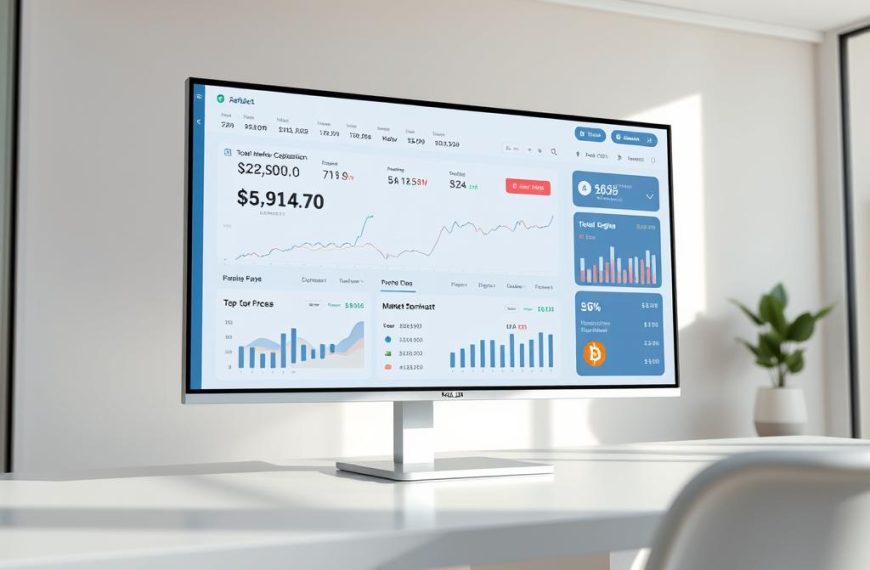Digital assets like Bitcoin represent a new form of money, operating without physical notes or centralized banks. The IRS defines them as digital representations of value, functioning as a medium of exchange. Unlike traditional cash, these systems rely on blockchain technology for secure, decentralized transactions.
Bitcoin dominates the market, with a $1.3 trillion valuation, showcasing the growth of virtual currency. Developing nations see rapid adoption, with a 34% increase reported in 2023. This highlights its role in enabling borderless payments.
Regulators like the SEC oversee exchanges, ensuring compliance. The EU’s MiCA framework further classifies these assets, emphasizing their global impact. As a subset of digital currency, cryptocurrency combines cryptographic security with financial innovation.
Understanding Virtual Currencies
Unlike traditional cash, digital money exists purely in electronic form. The Federal Reserve defines it as “digital representations not issued by government.” This key distinction separates these assets from fiat systems controlled by central banks.
Definition and Key Characteristics
These assets serve three core functions:
- Medium of exchange: Used for payments without physical bills
- Store of value: Preserves worth over time, though volatility exists
- Unit of account: Measures value like traditional money
Closed systems (e.g., gaming tokens) operate in restricted environments. Open networks like Bitcoin allow global participation. As noted in industry research, this flexibility enables broader financial access.
How Virtual Currencies Differ from Traditional Money
Speed sets digital assets apart. Bitcoin transactions confirm in ~10 minutes versus 3-5 banking days. The World Bank reports 62% faster processing compared to legacy systems.
“Decentralized networks eliminate intermediaries like SWIFT, reducing costs and delays.”
Venezuela’s Petro demonstrates how nations use these systems to bypass sanctions. Fixed supplies (e.g., Bitcoin’s 21M cap) also contrast with inflationary fiat printing.
Nearly 1.7 billion unbanked adults gain access through mobile-friendly digital wallets. However, regulatory uncertainty persists for cross-border payments.
Is Cryptocurrency Virtual Currency?
Bitcoin’s rise reshaped financial systems by introducing decentralized digital money. It meets all criteria for virtual currencies: digital existence, transactional utility, and independence from central banks. The SEC’s case against Ripple Labs further clarified this by classifying XRP as a “digital asset” used for payments.
How Crypto Fits the Virtual Currency Framework
El Salvador’s 2021 adoption of Bitcoin as legal tender proved its real-world use. Unlike gaming tokens like V-Bucks, crypto operates on open blockchain networks. Ethereum’s smart contracts exemplify programmable money, automating agreements without intermediaries.
“Decentralized networks like Bitcoin’s fulfill every function of traditional money—just without the physical form.”
Global Recognition and Regulatory Contrasts
Wyoming’s DAO Law recognizes decentralized organizations, while China bans crypto entirely. The IRS requires reporting transactions on Form 8949, treating them like property. Binance’s $4.3B settlement with U.S. regulators underscores compliance challenges.
Over 38,000 Bitcoin ATMs worldwide (CoinATMRadar) show growing adoption. Yet, hybrid projects like Facebook’s abandoned Diem reveal struggles to balance innovation and oversight.
Types of Virtual Currencies
Modern financial ecosystems now include specialized digital assets with distinct operational frameworks. These fall into two categories: closed-loop systems for specific platforms and open networks like Bitcoin. Understanding their differences clarifies how value moves in digital economies.
Closed Virtual Currencies
World of Warcraft Gold and airline miles exemplify closed systems. These non-convertible coins function like coupons, usable only within their native platforms. The $12B gaming virtual goods market (Newzoo 2023) thrives on such restricted currencies.
Key limitations include:
- No interoperability: Robux can’t buy Starbucks coffee
- Centralized control: Developers adjust supply or revoke access
- Tax ambiguity: IRS doesn’t classify them as taxable property
Celsius Network’s 2022 collapse revealed risks when closed-system tokens lose backing. Users couldn’t withdraw assets, unlike open-network crypto holders.
Open Virtual Currencies
Bitcoin and stablecoins like USDC operate globally. They’re convertible across exchanges and recognized by regulators. The IRS Notice 2014-21 treats them as property, requiring capital gains reporting.
“Open networks combine the utility of traditional money with blockchain’s transparency.”
Axie Infinity’s play-to-earn model shows hybrid potential. Players convert game tokens to Ethereum, bridging closed and open systems.
| Feature | Robux (Closed) | Bitcoin (Open) |
|---|---|---|
| Liquidity | Platform-only | Global exchanges |
| Value Stability | Fixed by developer | Market-driven |
| Tax Treatment | Non-taxable | Capital gains apply |
Enterprise adoption grows too. Walmart uses blockchain-based coins for supply chain payments, blending closed efficiency with open-system audit trails.
The Technology Behind Cryptocurrencies
At the core of digital finance lies blockchain, a revolutionary system that powers secure global transactions. This technology eliminates the need for intermediaries by distributing trust across a network of computers. Unlike traditional databases, it operates as a public, tamper-proof ledger.
Blockchain: The Foundation of Cryptocurrency
A blockchain is a chain of blocks, each storing transactions verified by network participants. Its immutability ensures data cannot be altered once recorded. Bitcoin uses SHA-256 hashing—a cryptographic process converting data into unique 64-character strings.
Key features include:
- Decentralization: No single entity controls the ledger.
- Transparency: All participants view the same transaction history.
- Security: Changing a block requires altering all subsequent blocks—a near-impossible feat.
How Nodes and Miners Support the Network
Bitcoin’s network relies on 400,000+ nodes (Bitnodes), each storing a copy of the blockchain. Full nodes validate every transaction, while lightweight SPV wallets verify headers only.
Miners compete to solve SHA-256 puzzles, consuming 145 exahashes/sec of power (Blockchain.com). Foundry USA controls 33% of this hash rate, showcasing mining pool dominance.
“Proof of Work (PoW) uses 0.12% of global electricity—versus 0.0028% for Proof of Stake (PoS).”
Kazakhstan’s coal-powered mining ban highlights environmental concerns. Meanwhile, Layer-2 solutions like Lightning Network scale capacity to 5,000+ BTC for faster payments.
How Virtual Currencies Are Used
Global financial systems now leverage digital assets for both speculative and practical purposes. With a $1.2T market cap and 425M users, these tools reshape how value moves worldwide.
Investment and Trading
Binance processes $40B in daily spot trades, highlighting retail and institutional demand. Derivatives like CME Bitcoin futures see $4B in open interest, reflecting sophisticated investment strategies.
DeFi protocols lock $55B in assets, enabling peer-to-peer lending without banks. However, SEC delays on ETF approvals show lingering regulatory hurdles for mainstream adoption.
Everyday Transactions and Financial Inclusion
Remittances cost 6.5% via digital assets versus 10.2% traditionally (World Bank). Over 15,000 businesses accept Bitcoin, from Microsoft to local cafes.
“Ukraine received $225M in war donations via crypto, bypassing traditional banking delays.”
CBDCs like the Digital Euro pilot aim to merge blockchain efficiency with central bank stability. For the unbanked, mobile wallets offer services previously out of reach.
Advantages of Virtual Currencies
Borderless transactions now operate without middlemen, thanks to decentralized networks. These systems cut costs, speed up payments, and open financial services to underserved populations. While not perfect, their benefits reshape global markets.
Lower Costs and Faster Transactions
Sending $100 abroad costs $0.50 via Bitcoin versus $25 for wire transfers. The BIS reports 70% faster cross-border settlements, saving users $1.5B annually in fees. Microtransactions thrive too—Brave Browser’s BAT token pays users $0.01 per ad view.
“Decentralized networks process payments in minutes, not days, bypassing SWIFT’s aging infrastructure.”
| Method | Cost per $100 | Speed |
|---|---|---|
| Bank Wire | $25 | 3–5 days |
| Bitcoin | $0.50 | 10 minutes |
| Stablecoin | $1.00 | 2 minutes |
Global Access and Censorship Resistance
Markets never close—trading happens 24/7, unlike stock exchanges. Argentina’s peso crisis saw Bitcoin surge 120% as a hedge. Tornado Cash’s sanctions reveal tensions: decentralized value flows can’t be easily stopped.
- Energy innovation: Crusoe Energy powers mining with wasted flare gas
- Smart contracts: Uniswap automated $1T+ swaps without brokers
- UX challenges: Non-tech users struggle with wallet setups
While revolutionary, these systems demand tech literacy. Still, they offer unmatched financial services to those excluded from banks.
Disadvantages of Virtual Currencies
While digital assets offer many benefits, they also come with significant drawbacks that users must consider. From theft to regulatory hurdles, these challenges impact both investors and everyday adopters.
Security Risks and Hacking Threats
Cybercriminals stole $3.8B in 2022, targeting exchanges and wallets. Poly Network’s $611M exploit revealed vulnerabilities in smart contracts. Once funds are gone, recovery is nearly impossible.
“Rug pulls like Squid Game token’s 99% crash show how fake projects exploit hype.”
FTX’s collapse left users with $8B in losses, proving even trusted platforms carry risk. Unlike banks, transactions can’t be reversed—a double-edged sword for security.
Regulatory and Legal Challenges
Over 300 new rules were proposed globally in 2023. The U.S. lacks federal standards, while the EU’s MiCA framework creates fragmentation. The IRS audits 35% of crypto tax filings due to reporting errors.
- Volatility: Bitcoin dropped 70% in 2022, destabilizing portfolios.
- Environmental cost: Mining emits 85Mt of CO2 annually.
- Legal gray areas: SEC lawsuits hinge on the Howey Test.
Government crackdowns and lost private keys ($140B in Bitcoin) add to the hurdles. These issues remind users that innovation often outpaces protection.
Regulatory Environment for Virtual Currencies
Regulatory frameworks for digital assets continue evolving as governments worldwide respond to rapid innovation. The 2024 FIT21 Act proposes clearer rules for classifying tokens as securities or commodities. This comes amid heightened SEC enforcement targeting major trading platforms.
US Regulatory Landscape
The SEC filed 46 enforcement actions in 2023, including cases against Coinbase and Binance. Wyoming’s SPDI licenses enable crypto-native banks to offer traditional services. Meanwhile, the CFTC asserts jurisdiction over commodity-linked digital assets through landmark cases.
“Our rules must adapt to protect investors without stifling responsible innovation.” – SEC Chair Gary Gensler
State-level approaches vary dramatically. New York’s BitLicense requires $100,000+ in compliance costs, while Texas favors mining-friendly policies. The DOJ’s Crypto Enforcement Team now prosecutes cross-border violations.
International Approaches
Europe’s MiCA framework mandates licensing for exchanges and stablecoin issuers. Singapore requires strict KYC checks under its Payment Services Act. China’s digital yuan reaches 26M wallets as the country bans private alternatives.
Key global contrasts include:
- El Salvador’s Bitcoin legal tender status versus IMF stability warnings
- FATF Travel Rule adoption delays in emerging markets
- OFAC’s sanctioning of privacy tools like Tornado Cash
| Region | Approach | Key Requirement |
|---|---|---|
| EU | Unified licensing | MiCA compliance by 2025 |
| Singapore | Strict AML | PSA capital requirements |
| China | State control | Digital yuan integration |
The ECB’s digital euro proposal highlights central bank responses to decentralized finance. As regulation matures, cross-border coordination remains the industry’s biggest challenge.
Cryptocurrency vs. Digital Currency vs. Virtual Currency
Financial systems now navigate a complex landscape where digital, virtual, and crypto-based assets intersect. Clear definitions matter for policymakers and users alike, as tax, legal, and functional differences shape adoption.
Key Differences and Overlaps
Central bank digital currencies (CBDCs), like China’s Digital Yuan, contrast sharply with decentralized networks. The BIS reports 94% of central banks are researching CBDCs, aiming to merge blockchain efficiency with state control.
Key distinctions include:
- Legal tender status: Only CBDCs are government-backed, while crypto relies on market trust.
- Programmable money: Ethereum automates contracts, whereas FedNow processes simple payments.
- Supply mechanisms: Bitcoin’s algorithmic cap (21M) vs. central banks’ inflationary tools.
“The IMF classifies assets by issuer and technology—a framework critical for global regulation.”
| Feature | CBDC | Crypto |
|---|---|---|
| Issuer | Central bank | Decentralized network |
| Tax Treatment | Like fiat | Property (IRS) |
| Interoperability | National systems | Cross-border |
Why Definitions Matter
Misclassification risks abound. The SEC’s lawsuit against Ripple hinged on whether XRP was a security or currency. Meanwhile, El Salvador’s Bitcoin adoption tests legal tender laws.
Monetary policy implications deepen the divide. CBDCs let central banks track supply in real-time, while crypto resists oversight. For users, tax rules vary widely—the IRS demands capital gains reporting for crypto but not airline miles.
Interoperability remains a hurdle. Projects like Project mBridge explore cross-border CBDCs, yet private networks (e.g., Diem’s failure) struggle with compliance.
The History of Cryptocurrency
Digital cash concepts predate Bitcoin by nearly 20 years, with key breakthroughs along the way. David Chaum’s DigiCash (1989) introduced cryptographic electronic payments, while Wei Dai’s b-money proposal (1998) outlined decentralized concepts. These early attempts lacked the blockchain architecture that would later revolutionize the world of finance.
From Bitcoin to Altcoins
Satoshi Nakamoto’s 2008 whitepaper solved the double-spend problem using proof-of-work. The Bitcoin network launched in 2009, creating the first functional decentralized currency. By 2011, alternative coins like Litecoin emerged, offering faster transactions through different hashing algorithms.
Key evolutionary steps included:
- 2013-2017 cycles: Bitcoin surged from $13 to $1,000, then crashed before reaching $20K
- Forks: Bitcoin Cash split in 2017 over block size debates
- Layer solutions: Lightning Network enabled micropayments in 2018
Major Milestones in Development
Ethereum’s 2015 launch introduced programmable money through smart contract software. This enabled:
“A new era of decentralized applications beyond simple payments.”
The 2017 ICO boom saw $22B raised for new projects, many later failing. DeFi Summer 2020 exploded with $60B locked in protocols. Meanwhile, institutional adoption grew—MicroStrategy holds $6B in Bitcoin as treasury reserve.
| Year | Event | Impact |
|---|---|---|
| 2010 | First BTC pizza | Proved real-world use |
| 2021 | NFT boom | Beeple’s $69M sale |
| 2022 | Ethereum Merge | 99% energy reduction |
Today, quantum computing poses new challenges to cryptographic security. The space continues evolving at unprecedented speed, with regulatory clarity still catching up to innovation.
Mining and Validation in Cryptocurrency Networks
Validation mechanisms form the backbone of decentralized networks, ensuring trust without intermediaries. These systems rely on participants called miners or validators, who use computer power to verify transactions and secure the process. Two dominant methods—Proof of Work (PoW) and Proof of Stake (PoS)—define how networks achieve consensus.
Proof of Work vs. Proof of Stake
PoW miners compete to solve cryptographic puzzles using ASICs or GPUs. Bitcoin’s SHA-256 algorithm demands massive energy, consuming 0.5% of global electricity. In contrast, PoS validators like Ethereum’s post-Merge system lock assets as collateral, cutting energy use by 99.9%.
“PoW secures networks through physical work, while PoS leverages economic stakes.”
Key differences:
- Hardware: ASICs dominate Bitcoin mining, while PoS requires minimal hardware.
- Rewards: PoW miners earn block rewards; PoS validators gain 5–10% APY from staking.
- Decentralization: PoW pools control 35% of Bitcoin’s hash rate (e.g., Foundry USA).
The Environmental Impact of Mining
Critics highlight Bitcoin’s carbon footprint—85Mt of CO2 annually. However, 58% of mining now uses renewable sources, like Texas’ wind-powered farms (35% hash rate share). Projects like Crusoe Energy repurpose flare gas, turning waste into computational power.
| Initiative | Impact |
|---|---|
| EIP-1559 | Burns fees, reducing ETH supply |
| Nordic heat reuse | Warms homes with mining excess |
| New York’s PoW ban | Pushes miners to greener states |
Carbon credit tokenization and regulatory shifts aim to balance innovation with environmental responsibility. As networks evolve, sustainability remains a core challenge for decentralized validation.
Stablecoins and Memecoins: Specialized Virtual Currencies
Specialized digital assets serve unique purposes in modern finance, from stable value storage to speculative trading. The $162 billion stablecoin market contrasts sharply with meme-driven coins like Dogecoin, which hit $0.73 in 2021. Both categories reshape how users interact with digital value.
How Stablecoins Maintain Value
Stablecoins peg their price to external assets like the US dollar. Tether (USDT) dominates with $112 billion in reserves, mostly US Treasury bills. Transparent alternatives like USDC provide weekly audits of cash-backed holdings.
Algorithmic models face higher risk. TerraUSD’s collapse erased $40 billion when its stabilization mechanism failed. Regulators now scrutinize reserves—the SEC forced Paxos to stop minting BUSD in 2023.
- Fiat-backed: USDT, USDC (1:1 dollar reserves)
- Crypto-collateralized: MakerDAO’s DAI (overcollateralized ETH)
- Algorithmic: Failed UST model (no direct backing)
The Rise and Risks of Memecoins
Shiba Inu’s 10,000,000% gain showcased memecoin volatility. Celebrity tokens like Caitlyn Jenner’s JENNER often crash after initial hype. Blockchain analysts at Nansen track wash trading patterns inflating volumes.
“The SEC fined Kim Kardashian $1.26M for promoting EthereumMax without disclosing payments.”
Unlike stablecoins, these coins lack utility. Dogecoin’s market swings demonstrate how social media drives price action. The SEC warns they’re high-risk investments, not currency replacements.
| Type | Example | Stability |
|---|---|---|
| Stablecoin | USDC | ±1% from peg |
| Memecoin | Dogecoin | 90-day volatility: 120% |
The Future of Virtual Currencies
Institutional adoption and AI integration signal a transformative phase for digital economies. ARK Invest predicts a $10T market by 2030, driven by ISO 20022-compliant assets and scalable blockchain technology. This growth hinges on solving interoperability and regulatory hurdles.
Emerging Trends and Technologies
AI-powered trading bots now manage 35% of crypto volumes, optimizing strategies with real-time data. Quantum-resistant algorithms, like XMSS, aim to safeguard networks against next-gen computing threats. Meanwhile, market capitalization trends show large-cap assets dominating 70% of liquidity.
Metaverse economies are booming. Decentraland’s virtual land sales hit $2.4M in Q1 2024, blending NFTs with interactive commerce. DAOs also gain traction—Uniswap’s governance token holders vote on $1B+ treasury allocations.
“Privacy coins face existential challenges as 38 nations implement FATF Travel Rules.”
Potential Challenges and Opportunities
Geopolitical tensions reshape asset flows. Russia’s gold-backed stablecoin circumvents sanctions, while the Digital Euro pilot tests CBDC efficiency. However, fragmented regulations risk stifling innovation—the U.S. lags behind the EU’s MiCA framework.
- Custody solutions: Fireblocks secures $500B for institutions, but 65% of breaches target hot wallets.
- Energy demands: Bitcoin mining’s 0.5% global electricity use spurs renewable innovations like hydro-cooled farms.
- Interoperability: Polkadot’s parachains enable cross-chain swaps, reducing Ethereum’s $50M daily gas fees.
| Trend | Impact | Projected Growth |
|---|---|---|
| AI-Crypto | Automated DeFi | 300% by 2025 |
| CBDCs | Centralized control | 130 nations exploring |
| Privacy Tech | Regulatory clashes | 20% adoption drop |
The future hinges on balancing innovation with stability. As technology evolves, assets bridging traditional and decentralized finance will dominate the global world of value exchange.
Conclusion
The financial landscape continues evolving as digital assets redefine value exchange. Over 1 billion users will engage with cryptocurrency by 2025, driven by faster transactions and decentralized finance tools.
Regulators are catching up—17% of U.S. adults now use virtual currency, while Bitcoin ETFs bridge traditional and digital markets. Yet volatility persists, requiring diversified investment strategies.
Innovations like Ethereum’s energy-efficient upgrades highlight the sector’s adaptability. As blockchain reshapes money systems, education remains key to navigating risks and opportunities.
Always consult financial experts before allocating funds to emerging assets. The future of finance is here, blending technology with global accessibility.


















